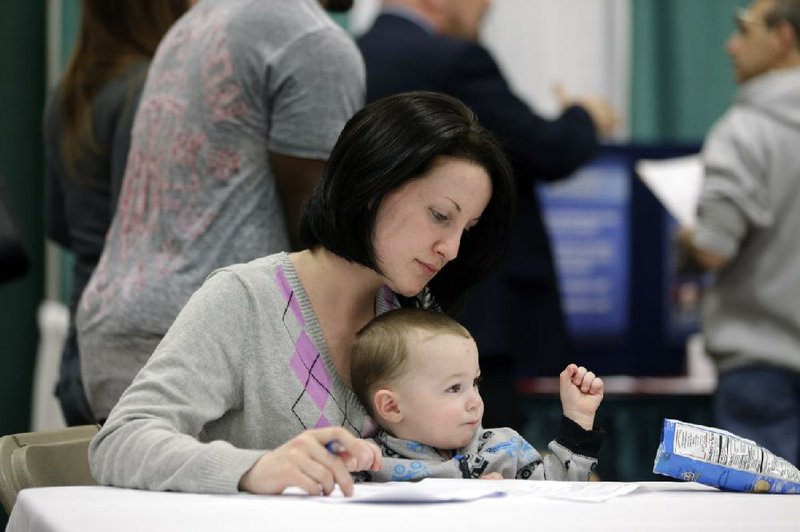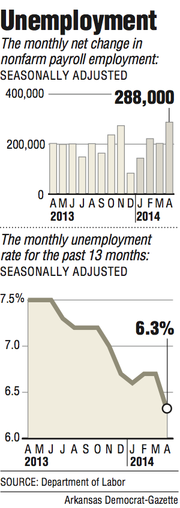WASHINGTON - U.S. employers added 288,000 jobs in April as the nation’s unemployment rate dropped to 6.3 percent, its lowest level in more than five years.
RELATED ARTICLE
http://www.arkansas…">U.S. factory orders increase 1.1%
April’s job growth - the most for a month in the past two years - provided confirmation that the U.S. economy is regaining its health after nearly stalling early this year because of a harsh winter, according to many economists. The March unemployment rate was 6.7 percent.
The department also revised upward the number of jobs that were created in February and March, raising job totals for those two months by a combined 36,000.
However, the Labor Department cautioned that the drop in the unemployment rate was partially due to a decline in the number of people working or seeking work. People aren’t counted as unemployed if they’re not looking for a job.
The employment and job figures corroborate the Federal Reserve’s view that the expansion is perking up after stagnating last quarter, indicating it will keep trimming its bond-buying stimulus program, analysts said.
“The economy is gathering momentum after the bad winter,” said Michael Gapen, senior U.S. economist at Barclays PLC in New York. “The unemployment rate will stay in its downward trend, which means tapering will continue.”
Employers added an average of 238,000 jobs in each of the past three months, up from 167,000 in the previous three.
Sal Guatieri, an economist at BMO Capital Markets, said the surge in hiring “signals that American companies are optimistic the economy will snap back smartly after the largely weather-related slump in the first quarter.”
Hiring last month was broad-based and included higher-paying jobs: Manufacturing gained 12,000, and construction was up 32,000. Professional and technical services, which include accounting and engineering positions, added 25,100 jobs. The number of government jobs grew 15,000, mostly at the local level.
Average hourly pay was unchanged at $24.31. Average wages have risen 1.9 percent in the past 12 months, just above the annual inflation rate of 1.5 percent. In a healthy economy, wages grow at roughly a 3 percent to 4 percent pace.
The drop in the unemployment rate from March’s 6.7 percent came as the Labor Department’s survey of households showed the labor force shrank by about 806,000 in April. The so-called participation rate, which indicates the share of working-age people in the labor force, decreased to 62.8 percent, matching the lowest level since 1978, from 63.2 percent a month earlier.
Americans are the most upbeat about finding a “quality job” than at any time since January 2008, according to Gallup data released April 25. A separate survey by the Conference Board shows the proportion of consumers who said jobs would become more plentiful in the next six months climbed in April to the highest level since January.
Many of those who stopped looking for work last month had been among the long-term unemployed - people out of work for six months or more. The number of long-term unemployed fell 300,000, the sharpest drop in 2½ years, to 3.5 million. Economists said most of them likely gave up looking for work rather than found jobs.
But Patrick O’Keefe, director of economic research at the consulting firm CohnReznick, said that figure tends to fluctuate sharply from month to month: The exodus of job seekers in April came after nearly 1.3 million people had begun working or looking for work in the first three months of the year.
Diane Swonk, an economist at Mesirow Financial, noted that the expiration of extended unemployment benefits at the end of 2013 likely fueled last month’s drop in the number of long-term unemployed. That’s because people are required to look for work to receive unemployment benefits. Once their benefits expired, many frustrated job seekers likely stopped looking.
The jump in hiring comes after a spate of other data showed that the economy is improving. Consumers are ramping up spending, businesses are ordering more goods, and manufacturers are expanding. The strengthening numbers show that harsh snowstorms and bitter cold in January and February were largely to blame for the economy’s scant growth at the start of the year.
The economy barely expanded from January through March, with the gross domestic product eking out an annual growth rate of 0.1 percent, down from a 2.6 percent rate in the final three months of 2013, according to the U.S. Commerce Department. Americans spent more last quarter on utilities and health care, but their spending on goods barely rose. Businesses also reduced spending, and exports fell.
Still, other data indicate that the economy was already rebounding in March and probably improved further in April. Consumers bought more cars and spent more at shopping malls. Household purchases, which account for about 70 percent of the economy, climbed 0.9 percent in March, the most since August 2009, the Commerce Department said Thursday.
Spending is up partly because Americans earned a bit more, and confidence has improved from the bleak winter months. Incomes rose 0.5 percent in March, the government said, the most since August.
And a private survey showed that manufacturing activity accelerated in April for a third straight month.
Businesses are also investing more in machinery and equipment after cutting back in those areas in January and December. Business orders for manufactured goods jumped in March, the government said last week.
All told, the positive news has led most economists to forecast a strong rebound in economic growth - to a 3.5 percent annual rate in the current April-June quarter. And growth should reach nearly 3 percent for the full year, up from 1.9 percent in 2013, they expect.
Information for this article was contributed by Christopher S. Rugaber of The Associated Press and by Michelle Jamrisko, Kristy Scheuble and Alan Ohnsman of Bloomberg News.
Front Section, Pages 1 on 05/03/2014


